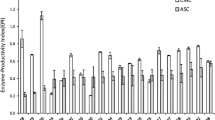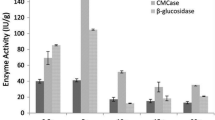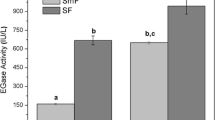Abstract
Currently, the high market price of cellulases prohibits commercialization of the lignocellulosics-to-fuel ethanol process, which utilizes enzymes for saccharification of cellulose. For this reason research aimed at understanding and improving cellulase production is still a hot topic in cellulase research. Trichoderma reesei RUT C30 is known to be one of the best hyper producing cellulolytic fungi, which makes it an ideal test organism for research. New findings could be adopted for industrial strains in the hope of improving enzyme yields, which in turn may result in lower market price of cellulases, thus making fuel ethanol more cost competitive with fossil fuels. Being one of the factors affecting the growth and cellulase production of T. reesei, the pH of cultivation is of major interest. In the present work, numerous pH-controlling strategies were compared both in shake-flask cultures and in a fermentor. Application of various buffer systems in shake-flask experiments was also tested. Although application of buffers resulted in slightly lower cellulase activity than that obtained in non-buffered medium, β-g1ucosidase production was increased greatly.
Access this chapter
Tax calculation will be finalised at checkout
Purchases are for personal use only
Preview
Unable to display preview. Download preview PDF.
Similar content being viewed by others
References
Ryu, D. D. Y. and Mandels, M. (1980), Enzyme Microb. Technol. 2, 91–102.
Kanson, A. L., Essam, S. A., and Zeinat, A. N. (1999), Polym. Degrad. Stabil. 63, 273–278.
Mukhopadhyay, S. and Nandi, B. (1999), J. Sci. Ind. Res. 58, 107–111.
Wayman, M. and Chen, S. (1992), Enzyme Microb. Technol. 14, 825–831.
Kadam, K. L. and Keutzer, W. J. (1995), Biotechnol. Lett. 17, 1111–1114.
Tangnu, S. K., Blanch, H. W., and Wilke, C. R. (1981), Biotechnol. Bioeng. 23, 1837–1849.
Hendy, N. A., Wilke, C. R., and Blanch, H. W. (1984), Enzyme Microb. Technol. 6, 73–77.
Doppelbauer, R., Esterbauer, H., Steiner, W., Lafferty, R. M., and Steinmüller, H. (1987), Appl. Microbiol. Biotechnol. 26, 485–494.
Mukhopadhyay, S. N. and Malik, R. K. (1980), Biotechnol. Bioeng. 22, 2237–2250.
Mandels, M. and Weber, J. (1969), Adv. Chem. Ser. 95, 391–414.
Sternberg, D. (1976), Biotechnol. Bioeng. Symp. 6(6), 35–53.
Chahal, D. S., McGuire, S., Pikor, H., and Noble, G. (1982), Biomass 2(2), 127–137.
Duff, S. J. B., Cooper, D. G., and Fuller, O. M. (1987), Enzyme Microb. Technol. 9, 47–51.
Yu, X.-B., Hyun S. Y., and Yoon-Mo, K. (1998), J. Microbiol. Biotechnol. 8, 208–213.
Mandels, M., Andreotti, R., and Roche, C. (1976), Biotechnol. Bioeng. Symp. 6(6), 21–33.
Berghem, L. E. E. and Petterson, L. G. (1976), Eur. J. Biochem. 46, 295–305.
Andreotti, R. E., Mandels, M., and Roche, C. (1977), in Bioconversion of Cellulosic Substrates into Energy, Chemicals and Microbial Protein: Proceedings of Bioconversion Symposium, Ghose, T. K., ed., Indian Institute of Technology, Delhi, pp. 249–267.
Author information
Authors and Affiliations
Editor information
Editors and Affiliations
Rights and permissions
Copyright information
© 2004 Springer Science+Business Media New York
About this paper
Cite this paper
Juhász, T., Szengyel, Z., Szijártó, N., Réczey, K. (2004). Effect of pH on Cellulase Production of Trichoderma reesei RUT C30. In: Finkelstein, M., McMillan, J.D., Davison, B.H., Evans, B. (eds) Proceedings of the Twenty-Fifth Symposium on Biotechnology for Fuels and Chemicals Held May 4–7, 2003, in Breckenridge, CO. Biotechnology for Fuels and Chemicals. Humana Press, Totowa, NJ. https://doi.org/10.1007/978-1-59259-837-3_18
Download citation
DOI: https://doi.org/10.1007/978-1-59259-837-3_18
Publisher Name: Humana Press, Totowa, NJ
Print ISBN: 978-1-4684-9873-8
Online ISBN: 978-1-59259-837-3
eBook Packages: Springer Book Archive




